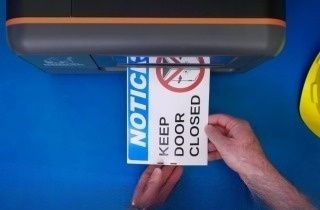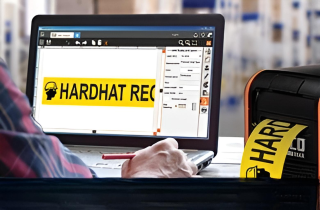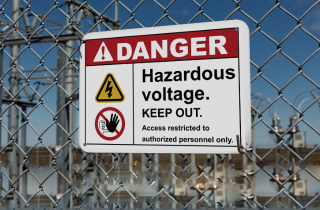A Practical Guide to Strategic Labeling Solutions with OSHA Labels

How Do OSHA-Compliant Labels Improve Safety and Efficiency?
Occupational Safety and Health Administration (OSHA)-compliant labels improve safety and efficiency by delivering clear, standardized communication about hazards, procedures, and equipment. These labels help prevent accidents, reduce errors, and enable workers to act quickly and confidently. As part of a broader strategic labeling approach, they guide employees to the right tools and actions—minimizing downtime and improving workflow.
The sections below break down how labeling solutions strengthen productivity and safety, and what happens when workplace labeling fails.
-
Why labeling solutions are often overlooked in efficiency efforts
-
The real costs of workplace labeling errors
-
How OSHA compliant labels reduce accidents and downtime
-
What strategic labeling systems look like in practice
-
How to keep labeling consistent as facilities change
Efficiency is essential for productivity and smooth operations in any workplace, and labeling is often an overlooked way to achieve it. According to a survey conducted by Loftware, 61% of respondents reported losses exceeding $50,000 due to mislabeling, and 77% experienced four or more production line stoppages in a single year because of label issues.
When integrated into a well-organized facility, OSHA-compliant labels reinforce both safety and workflow. They keep hazards visible, tasks clear, and operations moving without unnecessary disruption.
The Role of Strategic Labeling Solutions in an Efficient Workplace
Effective workplace labeling creates a work environment where employees can quickly locate items and complete tasks efficiently. When items have dedicated, labeled places—whether through pipe labels, equipment labels, or OSHA labels—employees spend less time searching and stay focused on their tasks. For instance, ammonia pipe labels help identify hazardous contents, which can reduce risks and ensure safe handling.
Workplace labeling reduces clutter and improves workflow by guiding employees to designated storage, work, and traffic zones. With clearly marked areas and 5S labeling, workers know exactly where to find and return materials, supporting a clean, organized workspace. In addition, labeling different task areas—such as assembly, packing, and shipping—prevents confusion and improves task flow.

Visual labeling systems, such as OSHA-compliant labels, ANSI color schemes, and GHS (Globally Harmonized System) labels, further enhance clarity:
- OSHA labels are applied directly to equipment, tools, or surfaces to highlight specific hazards, like moving parts on machinery or high-voltage areas.
- ANSI color-coded labels provide consistent visual cues, such as red for fire-related hazards or blue for required personal protective equipment (PPE), so workers can quickly interpret important safety information.
- GHS labels communicate chemical risks with globally recognized symbols for safe handling and storage.
These labeling systems work together to create a visual factory that promotes safety, efficiency, and organization. By leveraging labeling for structure and guidance, workplaces become more streamlined and accessible—allowing employees to focus on core tasks with minimal delays.
How Do Safety Labels Reduce Errors and Improve Workplace Safety?
Clear labeling is a powerful tool to enhance safety and minimize errors, and the right labeling solutions make those gains consistent across the facility. Labels such as warning labels and OSHA labels are essential for maintaining a secure, productive workspace with clearly marked hazards, PPE requirements, and emergency information. Below are some key ways strategic labeling improves safety and reduces mistakes.
Enhancing Safety Awareness
Industrial safety labels play a crucial role in communicating risks and hazards. In workplaces handling dangerous chemicals, GHS labels display critical handling information, while ammonia pipe labels help workers identify hazardous materials, ensuring proper procedures are followed. Clear safety information keeps employees informed, reduces accidents, and supports compliance with OSHA standards.
Preventing Errors and Misidentification
Errors in handling equipment or materials can have serious consequences. Labeling supports accuracy by guiding employees in identifying and properly managing items. Labels such as pipe labels and 5S labeling make it easy for workers to recognize specific materials and return tools to designated areas. This approach helps prevent mishandling or mixing incidents and improves visual organization across the facility.
Improving Efficiency Through Clear Visual Communication
When workers know where to find and how to handle equipment or materials, they spend less time second-guessing their actions. This minimizes disruptions and allows teams to focus on tasks with confidence. Whether through OSHA labels, ANSI visual cues, or industrial floor tape, clear labeling contributes to a safer, more productive environment.
What OSHA Labeling Requirements Apply to Workplace Safety?
A compliant facility is an efficient facility, and standardized labeling solutions help make that possible. OSHA has clear requirements for labeling hazardous materials, pipes, and machinery to protect workers and reduce the risk of accidents. Using proper OSHA labels not only ensures compliance but also reduces the chances of expensive fines, government inspections, and legal risks. It also boosts workplace organization and productivity.
For hazardous materials, OSHA’s Hazard Communication standard requires GHS labels that communicate the potential risks associated with substances, such as toxicity or flammability. These warning labels must be clear and informative to help workers handle chemicals safely. While OSHA does not have specific requirements for pipe labeling, it recommends following the ANSI standard A13.1. This standard outlines best practices for pipe labels—especially for hazardous contents like ammonia or chemicals—to avoid accidental exposure or mishandling.
In addition to hazardous materials, OSHA labels are required on machinery to indicate potential risks like moving parts or electrical hazards, as outlined in OSHA’s specifications for accident prevention signs and tags. Proper labeling for GHS, ANSI, and OSHA helps workers recognize hazards and take necessary precautions, such as wearing PPE, to reduce the risk of injury.
By following OSHA’s labeling requirements, businesses create a safer environment and avoid costly fines while also improving efficiency. Workers can identify hazards quickly, reduce the likelihood of errors, and keep operations running smoothly.
Best Practices for Effective Workplace Labeling
To ensure labels are effective, it’s essential to follow some best practices. Effective labels create a structured, organized environment where employees can quickly locate information, tools, and materials for streamlined operations.
Labels should be easy to read and placed in highly visible areas to ensure everyone can locate the necessary information quickly. Consider these tips for effective strategic labeling:
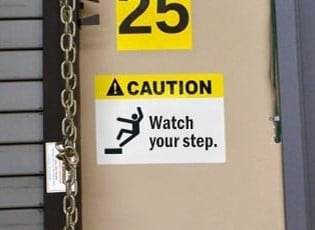
- Choose clear, concise language: Labels should convey the message quickly without excess text. For example, "Watch your step" communicates a fall hazard more effectively than a long-winded phrase like "Caution: Please be aware of uneven floor conditions that may result in tripping."
- Use standardized symbols: Symbols on OSHA labels, GHS, and ANSI compliant signs help communicate essential safety information at a glance. For instance, a flame symbol on a chemical container quickly signals flammability.
- Assess conditions and apply durable materials: In industrial settings, labels may face moisture, heat, chemicals, or wear. Use high-quality materials that can withstand these elements. For example, ammonia pipe labels designed for chemical exposure ensure durability in harsh environments.
- Color-code labels: Color coding is a simple and effective way to differentiate areas, items, and hazards. For instance, red warning labels or blue pipe labels enhance visual communication. Using industrial floor tape can further reinforce boundaries and pathways.
- Design labels to support organizational systems: Utilize 5S labeling to mark locations for tools, equipment, and materials. Consistent formatting and placement help workers return items to the correct spots and reinforce order throughout the facility.
Implementing these practices ensures your labels are clear and long-lasting, preventing frequent replacements and enhancing output across the workplace.
Which Labels Improve Workplace Efficiency?
Strategic labeling plays a critical role in maintaining organization and strong workplace labeling systems help streamline workflows. The following examples show how various types of OSHA labels, equipment tags, and floor marking tools can contribute to a more efficient, visual factory environment:
- Tool Shadow Boards: Labels on tool boards or outlines on surfaces indicate where each tool should be returned after use, helping prevent misplaced or lost tools.
- Storage Labels: Labeling bins, shelves, and cabinets simplifies inventory organization, making it easier for workers to find materials quickly.
- Barcodes and QR Codes: Scannable labels provide instant access to detailed information about inventory, equipment, or processes.
- Equipment ID Tags: Labels identifying machinery and tools make it easy for employees to find the correct equipment without confusion.
- Process Instructions: Step-by-step labels guide employees through complex processes to reduce errors and minimize training time.
- Lockout/Tagout Labels: Labels used in energy control programs ensure compliance with OSHA standards, promoting safe maintenance and reducing hazards.
Each of these labeling practices helps reduce wasted time, supports organization, and maintains a streamlined workflow. Facilities can achieve greater workplace efficiency and productivity by adopting a combination of these methods.
DuraLabel® Labeling Solutions
Workplace labeling offers a straightforward, impactful way to improve efficiency by organizing, communicating, and ensuring safety. Whether by guiding employees on where items belong or reinforcing safety protocols, labels are valuable assets in any facility. For companies looking to streamline operations, DuraLabel offers a range of durable labeling solutions, including industrial safety labels.
For those ready to elevate their labeling practices, DuraLabel’s Toro® Max Industrial Sign and Label System Starter Kit is an ideal solution, providing professional-grade tools to support efficient, effective labeling. By implementing high-quality labels in your workplace, you’re not only optimizing workflow but also creating a safer, more organized environment that can support productivity and safety over the long term.
Want to learn more about creating an OSHA-compliant facility? Download the OSHA Signage Quick Start Guide to discover the best methods for regulatory compliance.
Read Next:
Creating a Visual Factory with the 5S System
Why Tough Mechanical Environments Require Durable Labels
Related Resources

Redefining Job Site Safety Through Better Custom Labeling
How Do Contractors Use Labels and Signs for Better Job Site Safety? The final steps of a project are just as ...
Read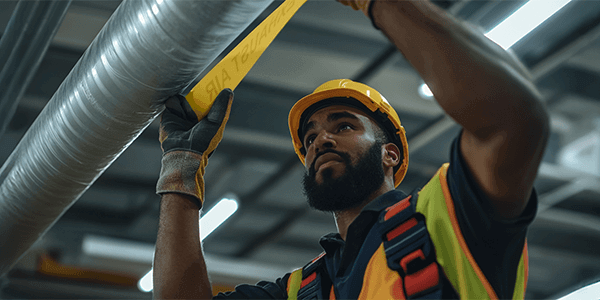
Why Custom Industrial Labels Matter for Mechanical Job Sites
How Do Custom Industrial Labels Improve Safety and Organization on Job Sites? Mechanical job sites are ...
Read
How to Improve Eyewash Station Safety in Healthcare Workspaces
How to Improve Eyewash Station Safety in Clinical and Lab Settings Our eyes are vulnerable in high-risk ...
Read.png)

